Judgment and Decision-Making: Political, Cultural, Groupthink
VerifiedAdded on 2021/06/15
|6
|1399
|34
Essay
AI Summary
This essay delves into the multifaceted aspects of judgment and decision-making within organizational settings. It begins by exploring political bargaining power, examining how it shapes internal dynamics and influences crucial decisions such as resource allocation and employee management. The essay then contrasts national cultural norms with organizational norms, analyzing their interaction and impact on corporate judgments, particularly in a globalized economic environment. It emphasizes how both norms affect recruitment, selection, and overall organizational performance. Finally, the essay addresses the phenomenon of groupthink, outlining its symptoms and providing a real-life example to illustrate how conformity and the suppression of dissenting opinions can lead to irrational decisions. The analysis draws on various scholarly sources to support its arguments, offering a comprehensive understanding of these critical leadership and management concepts.
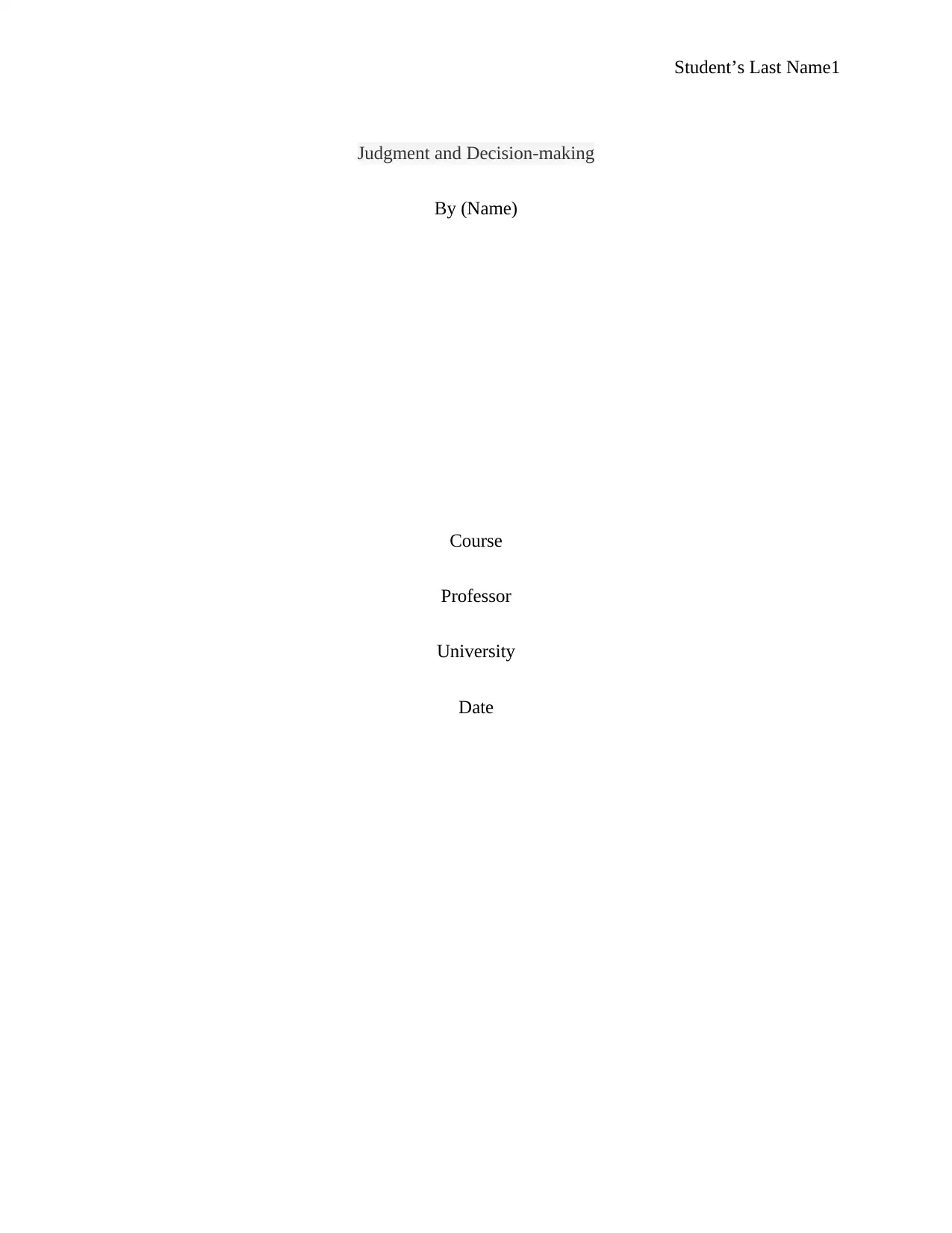
Student’s Last Name1
Judgment and Decision-making
By (Name)
Course
Professor
University
Date
Judgment and Decision-making
By (Name)
Course
Professor
University
Date
Paraphrase This Document
Need a fresh take? Get an instant paraphrase of this document with our AI Paraphraser
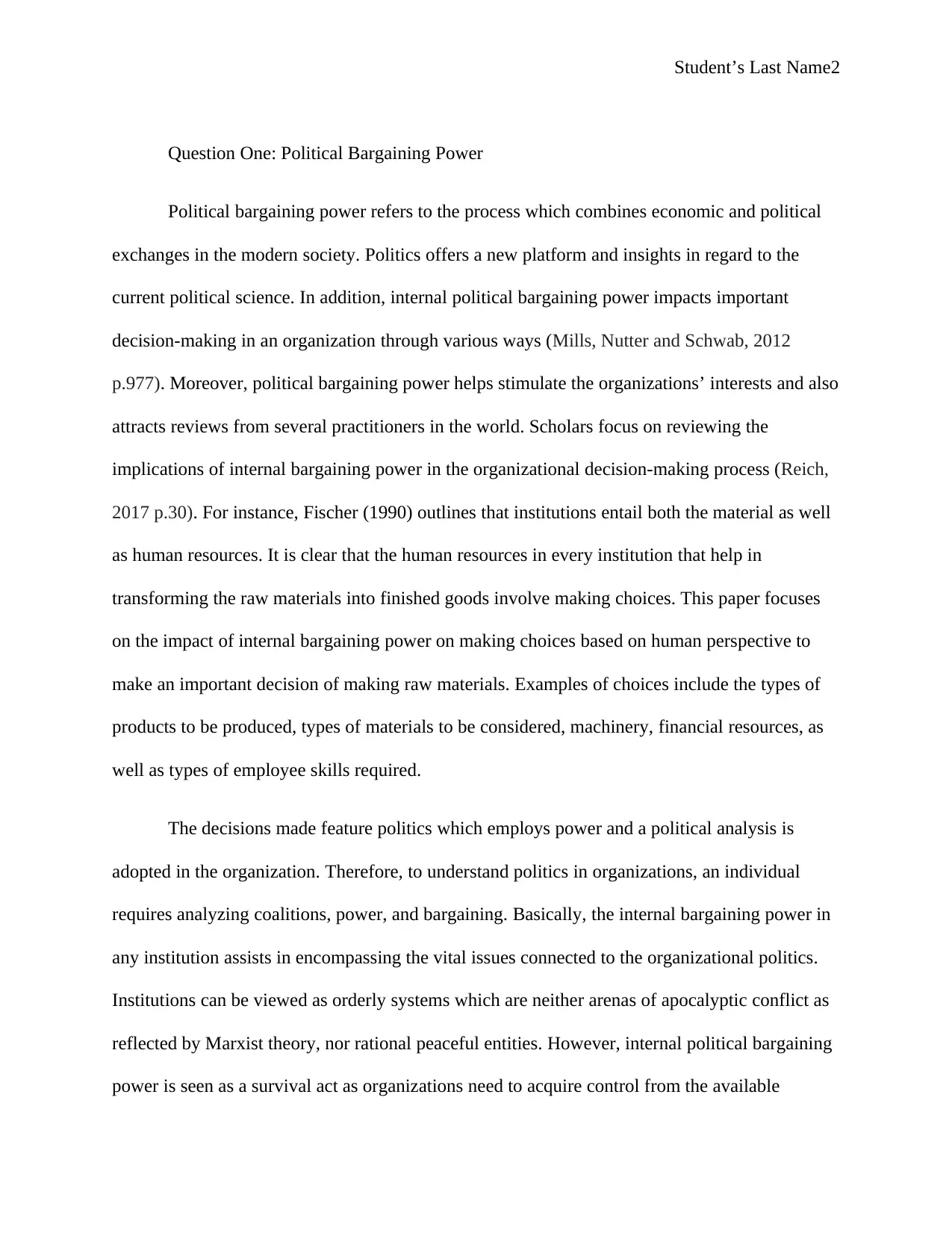
Student’s Last Name2
Question One: Political Bargaining Power
Political bargaining power refers to the process which combines economic and political
exchanges in the modern society. Politics offers a new platform and insights in regard to the
current political science. In addition, internal political bargaining power impacts important
decision-making in an organization through various ways (Mills, Nutter and Schwab, 2012
p.977). Moreover, political bargaining power helps stimulate the organizations’ interests and also
attracts reviews from several practitioners in the world. Scholars focus on reviewing the
implications of internal bargaining power in the organizational decision-making process (Reich,
2017 p.30). For instance, Fischer (1990) outlines that institutions entail both the material as well
as human resources. It is clear that the human resources in every institution that help in
transforming the raw materials into finished goods involve making choices. This paper focuses
on the impact of internal bargaining power on making choices based on human perspective to
make an important decision of making raw materials. Examples of choices include the types of
products to be produced, types of materials to be considered, machinery, financial resources, as
well as types of employee skills required.
The decisions made feature politics which employs power and a political analysis is
adopted in the organization. Therefore, to understand politics in organizations, an individual
requires analyzing coalitions, power, and bargaining. Basically, the internal bargaining power in
any institution assists in encompassing the vital issues connected to the organizational politics.
Institutions can be viewed as orderly systems which are neither arenas of apocalyptic conflict as
reflected by Marxist theory, nor rational peaceful entities. However, internal political bargaining
power is seen as a survival act as organizations need to acquire control from the available
Question One: Political Bargaining Power
Political bargaining power refers to the process which combines economic and political
exchanges in the modern society. Politics offers a new platform and insights in regard to the
current political science. In addition, internal political bargaining power impacts important
decision-making in an organization through various ways (Mills, Nutter and Schwab, 2012
p.977). Moreover, political bargaining power helps stimulate the organizations’ interests and also
attracts reviews from several practitioners in the world. Scholars focus on reviewing the
implications of internal bargaining power in the organizational decision-making process (Reich,
2017 p.30). For instance, Fischer (1990) outlines that institutions entail both the material as well
as human resources. It is clear that the human resources in every institution that help in
transforming the raw materials into finished goods involve making choices. This paper focuses
on the impact of internal bargaining power on making choices based on human perspective to
make an important decision of making raw materials. Examples of choices include the types of
products to be produced, types of materials to be considered, machinery, financial resources, as
well as types of employee skills required.
The decisions made feature politics which employs power and a political analysis is
adopted in the organization. Therefore, to understand politics in organizations, an individual
requires analyzing coalitions, power, and bargaining. Basically, the internal bargaining power in
any institution assists in encompassing the vital issues connected to the organizational politics.
Institutions can be viewed as orderly systems which are neither arenas of apocalyptic conflict as
reflected by Marxist theory, nor rational peaceful entities. However, internal political bargaining
power is seen as a survival act as organizations need to acquire control from the available
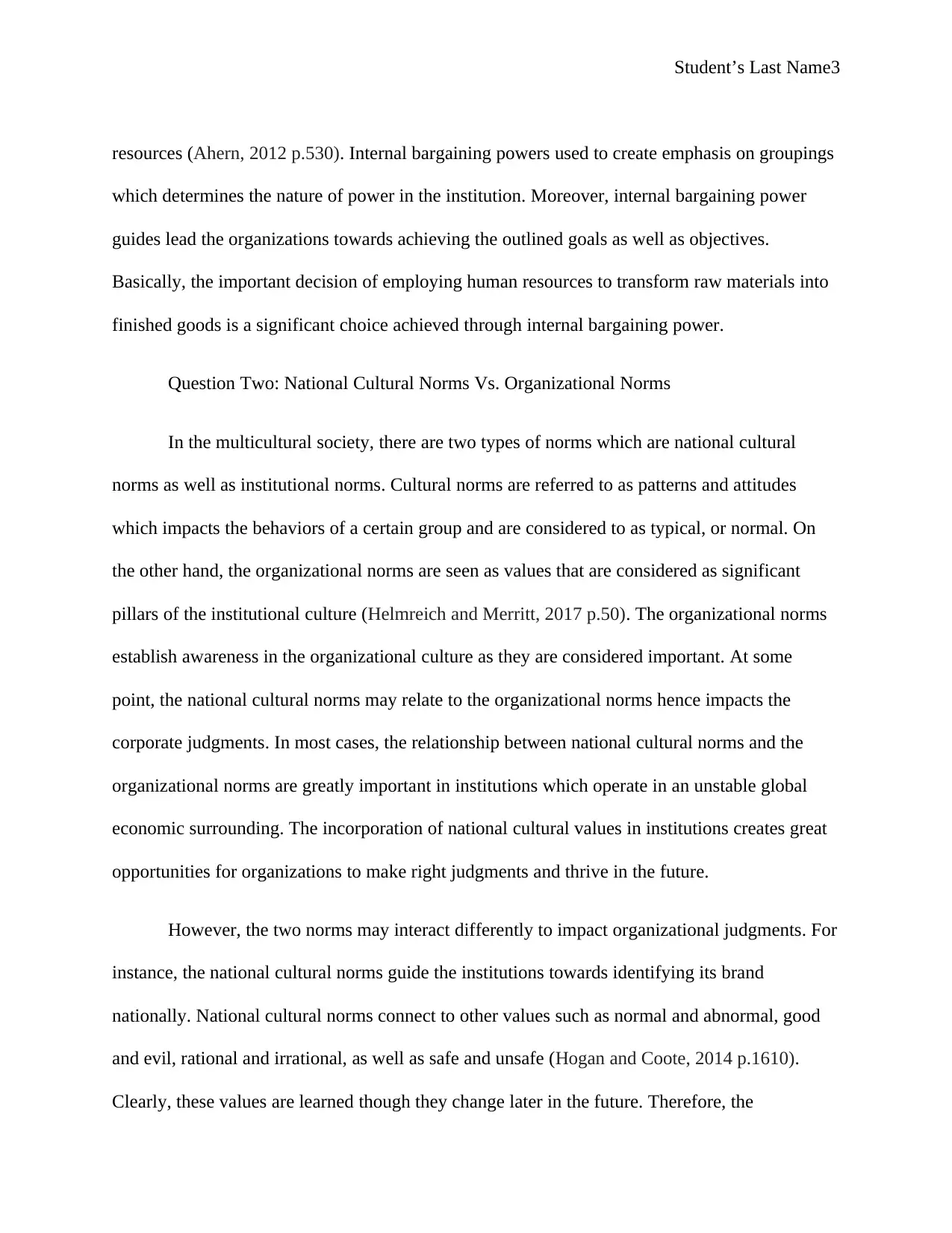
Student’s Last Name3
resources (Ahern, 2012 p.530). Internal bargaining powers used to create emphasis on groupings
which determines the nature of power in the institution. Moreover, internal bargaining power
guides lead the organizations towards achieving the outlined goals as well as objectives.
Basically, the important decision of employing human resources to transform raw materials into
finished goods is a significant choice achieved through internal bargaining power.
Question Two: National Cultural Norms Vs. Organizational Norms
In the multicultural society, there are two types of norms which are national cultural
norms as well as institutional norms. Cultural norms are referred to as patterns and attitudes
which impacts the behaviors of a certain group and are considered to as typical, or normal. On
the other hand, the organizational norms are seen as values that are considered as significant
pillars of the institutional culture (Helmreich and Merritt, 2017 p.50). The organizational norms
establish awareness in the organizational culture as they are considered important. At some
point, the national cultural norms may relate to the organizational norms hence impacts the
corporate judgments. In most cases, the relationship between national cultural norms and the
organizational norms are greatly important in institutions which operate in an unstable global
economic surrounding. The incorporation of national cultural values in institutions creates great
opportunities for organizations to make right judgments and thrive in the future.
However, the two norms may interact differently to impact organizational judgments. For
instance, the national cultural norms guide the institutions towards identifying its brand
nationally. National cultural norms connect to other values such as normal and abnormal, good
and evil, rational and irrational, as well as safe and unsafe (Hogan and Coote, 2014 p.1610).
Clearly, these values are learned though they change later in the future. Therefore, the
resources (Ahern, 2012 p.530). Internal bargaining powers used to create emphasis on groupings
which determines the nature of power in the institution. Moreover, internal bargaining power
guides lead the organizations towards achieving the outlined goals as well as objectives.
Basically, the important decision of employing human resources to transform raw materials into
finished goods is a significant choice achieved through internal bargaining power.
Question Two: National Cultural Norms Vs. Organizational Norms
In the multicultural society, there are two types of norms which are national cultural
norms as well as institutional norms. Cultural norms are referred to as patterns and attitudes
which impacts the behaviors of a certain group and are considered to as typical, or normal. On
the other hand, the organizational norms are seen as values that are considered as significant
pillars of the institutional culture (Helmreich and Merritt, 2017 p.50). The organizational norms
establish awareness in the organizational culture as they are considered important. At some
point, the national cultural norms may relate to the organizational norms hence impacts the
corporate judgments. In most cases, the relationship between national cultural norms and the
organizational norms are greatly important in institutions which operate in an unstable global
economic surrounding. The incorporation of national cultural values in institutions creates great
opportunities for organizations to make right judgments and thrive in the future.
However, the two norms may interact differently to impact organizational judgments. For
instance, the national cultural norms guide the institutions towards identifying its brand
nationally. National cultural norms connect to other values such as normal and abnormal, good
and evil, rational and irrational, as well as safe and unsafe (Hogan and Coote, 2014 p.1610).
Clearly, these values are learned though they change later in the future. Therefore, the
⊘ This is a preview!⊘
Do you want full access?
Subscribe today to unlock all pages.

Trusted by 1+ million students worldwide
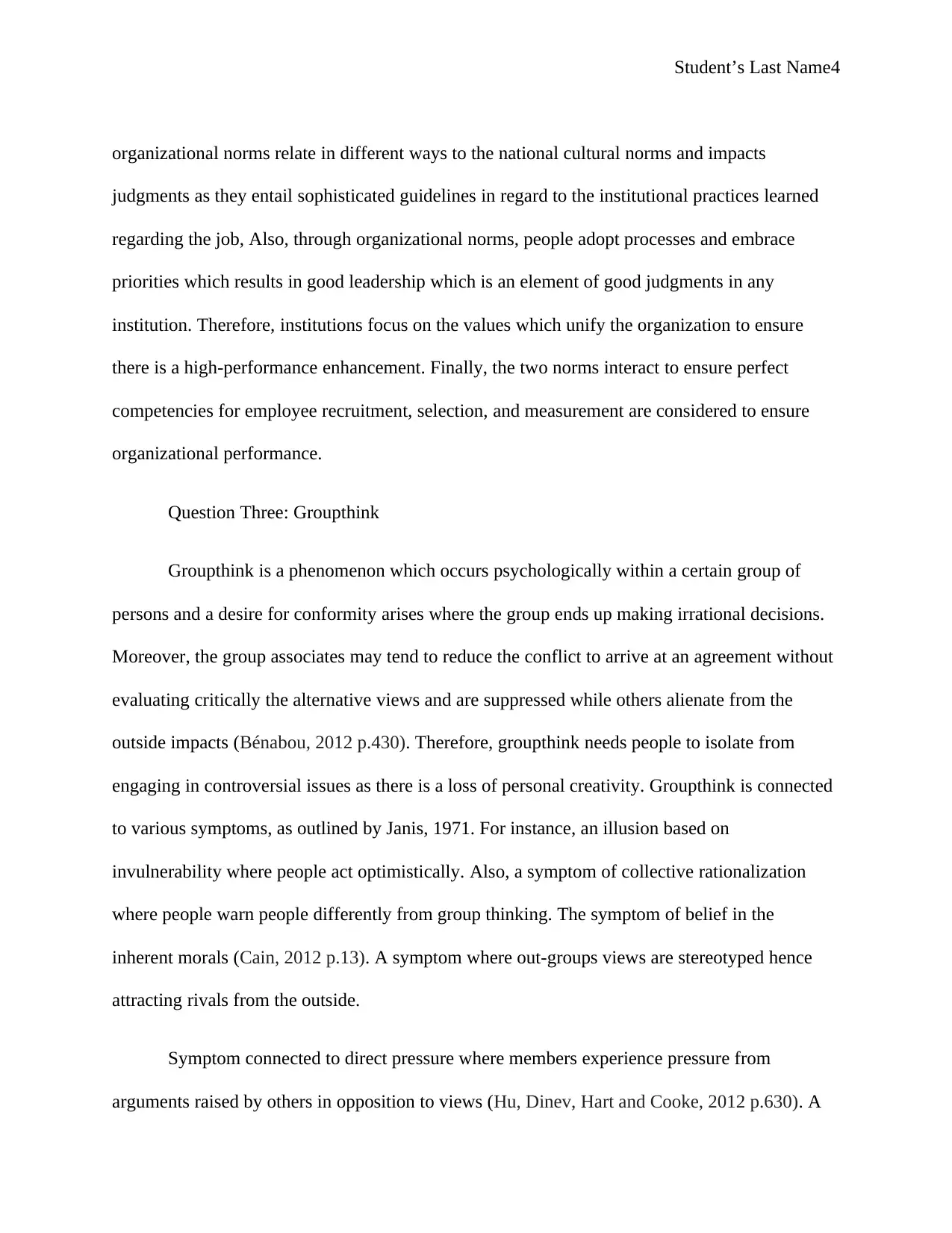
Student’s Last Name4
organizational norms relate in different ways to the national cultural norms and impacts
judgments as they entail sophisticated guidelines in regard to the institutional practices learned
regarding the job, Also, through organizational norms, people adopt processes and embrace
priorities which results in good leadership which is an element of good judgments in any
institution. Therefore, institutions focus on the values which unify the organization to ensure
there is a high-performance enhancement. Finally, the two norms interact to ensure perfect
competencies for employee recruitment, selection, and measurement are considered to ensure
organizational performance.
Question Three: Groupthink
Groupthink is a phenomenon which occurs psychologically within a certain group of
persons and a desire for conformity arises where the group ends up making irrational decisions.
Moreover, the group associates may tend to reduce the conflict to arrive at an agreement without
evaluating critically the alternative views and are suppressed while others alienate from the
outside impacts (Bénabou, 2012 p.430). Therefore, groupthink needs people to isolate from
engaging in controversial issues as there is a loss of personal creativity. Groupthink is connected
to various symptoms, as outlined by Janis, 1971. For instance, an illusion based on
invulnerability where people act optimistically. Also, a symptom of collective rationalization
where people warn people differently from group thinking. The symptom of belief in the
inherent morals (Cain, 2012 p.13). A symptom where out-groups views are stereotyped hence
attracting rivals from the outside.
Symptom connected to direct pressure where members experience pressure from
arguments raised by others in opposition to views (Hu, Dinev, Hart and Cooke, 2012 p.630). A
organizational norms relate in different ways to the national cultural norms and impacts
judgments as they entail sophisticated guidelines in regard to the institutional practices learned
regarding the job, Also, through organizational norms, people adopt processes and embrace
priorities which results in good leadership which is an element of good judgments in any
institution. Therefore, institutions focus on the values which unify the organization to ensure
there is a high-performance enhancement. Finally, the two norms interact to ensure perfect
competencies for employee recruitment, selection, and measurement are considered to ensure
organizational performance.
Question Three: Groupthink
Groupthink is a phenomenon which occurs psychologically within a certain group of
persons and a desire for conformity arises where the group ends up making irrational decisions.
Moreover, the group associates may tend to reduce the conflict to arrive at an agreement without
evaluating critically the alternative views and are suppressed while others alienate from the
outside impacts (Bénabou, 2012 p.430). Therefore, groupthink needs people to isolate from
engaging in controversial issues as there is a loss of personal creativity. Groupthink is connected
to various symptoms, as outlined by Janis, 1971. For instance, an illusion based on
invulnerability where people act optimistically. Also, a symptom of collective rationalization
where people warn people differently from group thinking. The symptom of belief in the
inherent morals (Cain, 2012 p.13). A symptom where out-groups views are stereotyped hence
attracting rivals from the outside.
Symptom connected to direct pressure where members experience pressure from
arguments raised by others in opposition to views (Hu, Dinev, Hart and Cooke, 2012 p.630). A
Paraphrase This Document
Need a fresh take? Get an instant paraphrase of this document with our AI Paraphraser
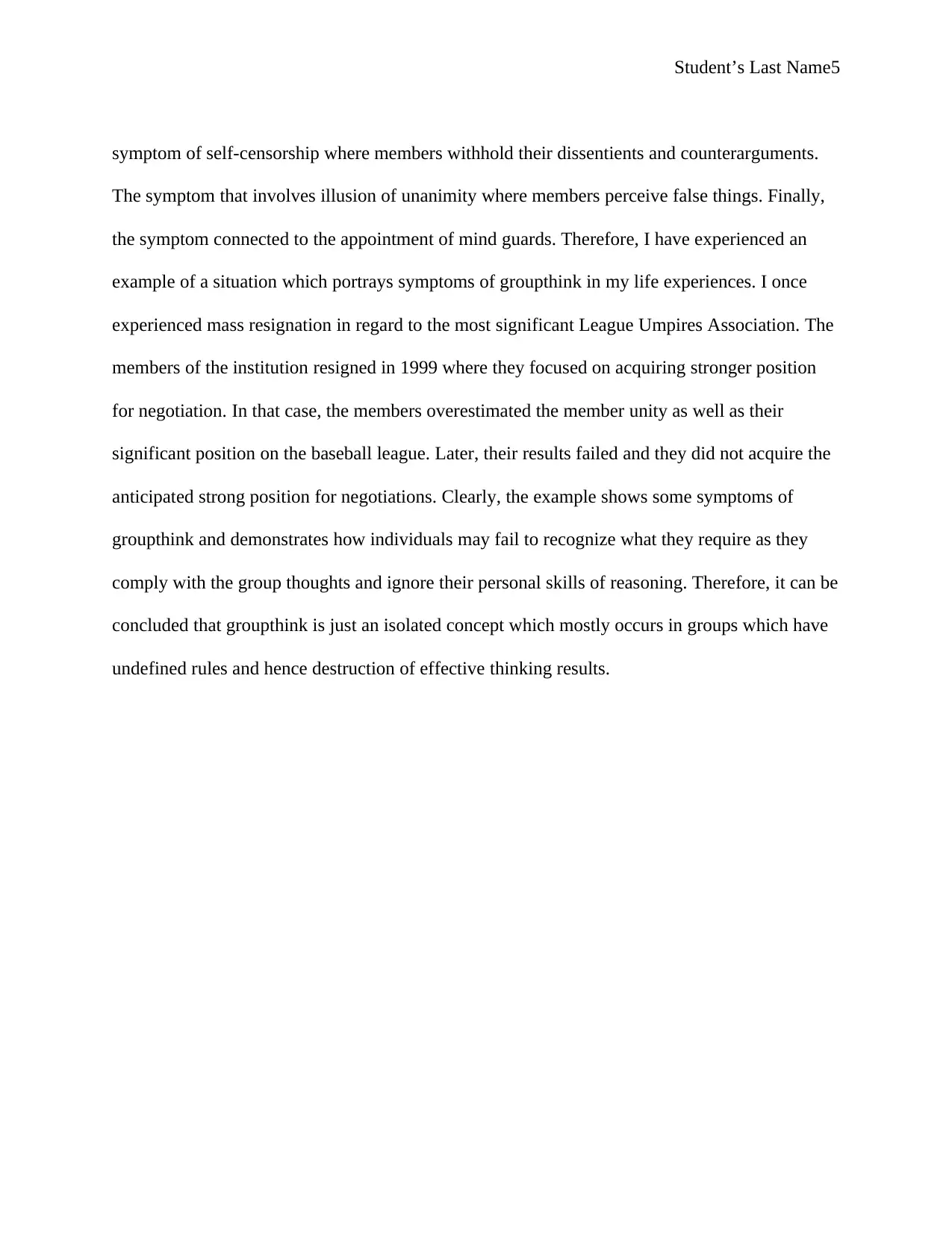
Student’s Last Name5
symptom of self-censorship where members withhold their dissentients and counterarguments.
The symptom that involves illusion of unanimity where members perceive false things. Finally,
the symptom connected to the appointment of mind guards. Therefore, I have experienced an
example of a situation which portrays symptoms of groupthink in my life experiences. I once
experienced mass resignation in regard to the most significant League Umpires Association. The
members of the institution resigned in 1999 where they focused on acquiring stronger position
for negotiation. In that case, the members overestimated the member unity as well as their
significant position on the baseball league. Later, their results failed and they did not acquire the
anticipated strong position for negotiations. Clearly, the example shows some symptoms of
groupthink and demonstrates how individuals may fail to recognize what they require as they
comply with the group thoughts and ignore their personal skills of reasoning. Therefore, it can be
concluded that groupthink is just an isolated concept which mostly occurs in groups which have
undefined rules and hence destruction of effective thinking results.
symptom of self-censorship where members withhold their dissentients and counterarguments.
The symptom that involves illusion of unanimity where members perceive false things. Finally,
the symptom connected to the appointment of mind guards. Therefore, I have experienced an
example of a situation which portrays symptoms of groupthink in my life experiences. I once
experienced mass resignation in regard to the most significant League Umpires Association. The
members of the institution resigned in 1999 where they focused on acquiring stronger position
for negotiation. In that case, the members overestimated the member unity as well as their
significant position on the baseball league. Later, their results failed and they did not acquire the
anticipated strong position for negotiations. Clearly, the example shows some symptoms of
groupthink and demonstrates how individuals may fail to recognize what they require as they
comply with the group thoughts and ignore their personal skills of reasoning. Therefore, it can be
concluded that groupthink is just an isolated concept which mostly occurs in groups which have
undefined rules and hence destruction of effective thinking results.
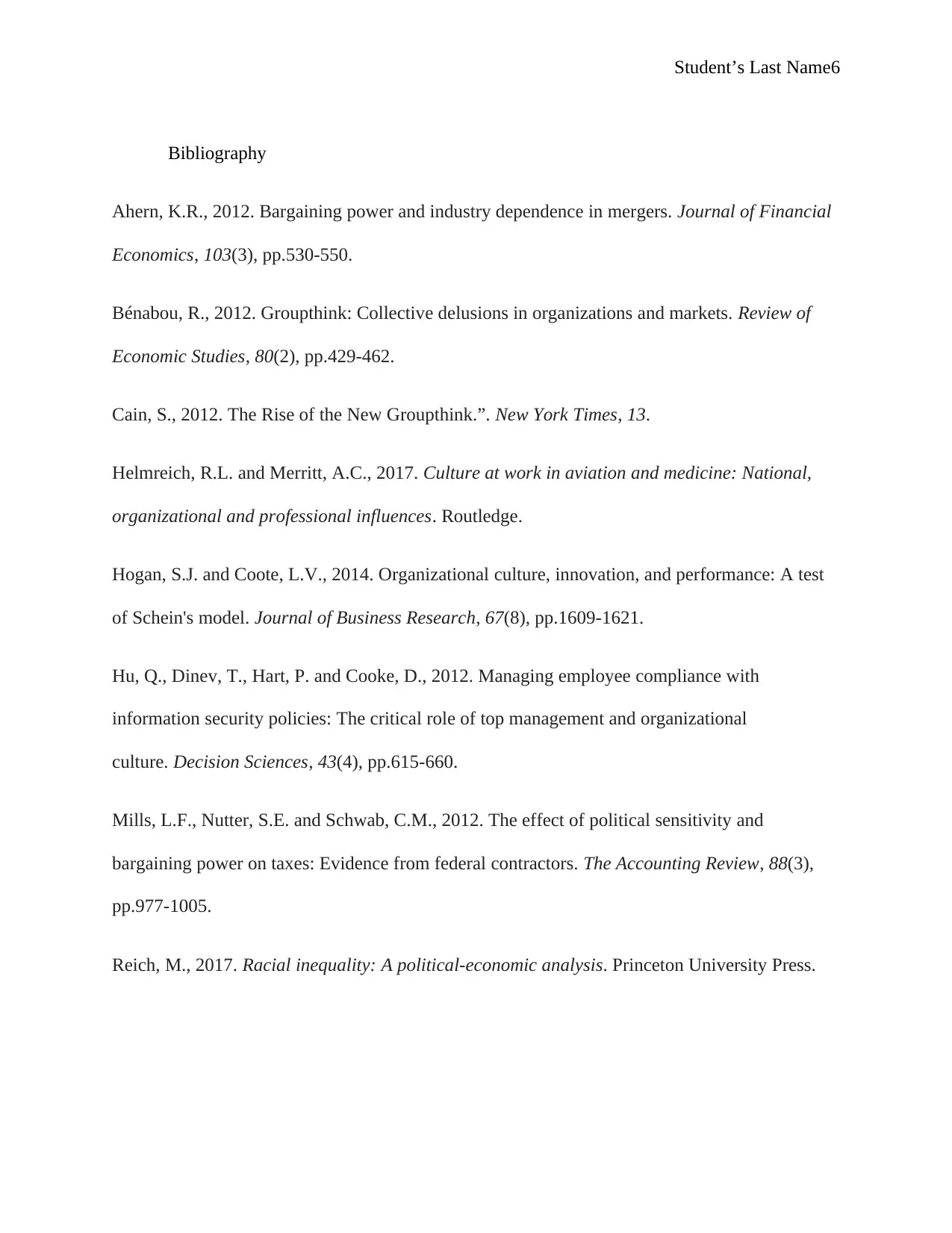
Student’s Last Name6
Bibliography
Ahern, K.R., 2012. Bargaining power and industry dependence in mergers. Journal of Financial
Economics, 103(3), pp.530-550.
Bénabou, R., 2012. Groupthink: Collective delusions in organizations and markets. Review of
Economic Studies, 80(2), pp.429-462.
Cain, S., 2012. The Rise of the New Groupthink.”. New York Times, 13.
Helmreich, R.L. and Merritt, A.C., 2017. Culture at work in aviation and medicine: National,
organizational and professional influences. Routledge.
Hogan, S.J. and Coote, L.V., 2014. Organizational culture, innovation, and performance: A test
of Schein's model. Journal of Business Research, 67(8), pp.1609-1621.
Hu, Q., Dinev, T., Hart, P. and Cooke, D., 2012. Managing employee compliance with
information security policies: The critical role of top management and organizational
culture. Decision Sciences, 43(4), pp.615-660.
Mills, L.F., Nutter, S.E. and Schwab, C.M., 2012. The effect of political sensitivity and
bargaining power on taxes: Evidence from federal contractors. The Accounting Review, 88(3),
pp.977-1005.
Reich, M., 2017. Racial inequality: A political-economic analysis. Princeton University Press.
Bibliography
Ahern, K.R., 2012. Bargaining power and industry dependence in mergers. Journal of Financial
Economics, 103(3), pp.530-550.
Bénabou, R., 2012. Groupthink: Collective delusions in organizations and markets. Review of
Economic Studies, 80(2), pp.429-462.
Cain, S., 2012. The Rise of the New Groupthink.”. New York Times, 13.
Helmreich, R.L. and Merritt, A.C., 2017. Culture at work in aviation and medicine: National,
organizational and professional influences. Routledge.
Hogan, S.J. and Coote, L.V., 2014. Organizational culture, innovation, and performance: A test
of Schein's model. Journal of Business Research, 67(8), pp.1609-1621.
Hu, Q., Dinev, T., Hart, P. and Cooke, D., 2012. Managing employee compliance with
information security policies: The critical role of top management and organizational
culture. Decision Sciences, 43(4), pp.615-660.
Mills, L.F., Nutter, S.E. and Schwab, C.M., 2012. The effect of political sensitivity and
bargaining power on taxes: Evidence from federal contractors. The Accounting Review, 88(3),
pp.977-1005.
Reich, M., 2017. Racial inequality: A political-economic analysis. Princeton University Press.
⊘ This is a preview!⊘
Do you want full access?
Subscribe today to unlock all pages.

Trusted by 1+ million students worldwide
1 out of 6
Related Documents
Your All-in-One AI-Powered Toolkit for Academic Success.
+13062052269
info@desklib.com
Available 24*7 on WhatsApp / Email
![[object Object]](/_next/static/media/star-bottom.7253800d.svg)
Unlock your academic potential
Copyright © 2020–2025 A2Z Services. All Rights Reserved. Developed and managed by ZUCOL.





